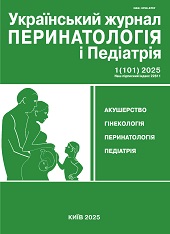Clinical features of 5-year-old girl with 22q11.2 deletion syndrome in a 5-year-old girl. To the 60th anniversary of the first description of DiGeorge syndrome
DOI:
https://doi.org/10.15574/PP.2025.1(101).135142Keywords:
DiGeorge syndrome, 22q11.2 chromosome deletion, A.M. Di George's biography, aspects of the syndrome's study, clinical manifestations, genetic diagnosticsAbstract
Since the article is devoted to the 60th anniversary of the definition of DiGeorge syndrome, it describes the biographical data of pediatric endocrinologist A.M. DiGeorge, the essential aspects of the syndrome's study, the main clinical presentation and diagnosis.
Aim - to reflect A.M. DiGeorge's important contribution to the current understanding of the syndrome and present a personal clinical observation of a child with 22q11.2 deletion syndrome.
Clinical case. A 5-year-old girl had such clinical symptoms as heart defects – multiple ventricular septal defects (Ø 10 mm perimembranous defect and Ø 2 mm apical muscular defect), secondary atrial septal defect, and high arterial hypertension; thymus aplasia was accompanied by moderate lymphopenia, reduced T-lymphocyte level, and decreased IgG level during the first two years of life (frequent viral respiratory diseases clinically manifested immunodeficiency); craniofacial dysmorphism; low levels of parathyroid hormone with normal levels of calcium in the blood; delayed speech development, dysarthria; cognitive deficit of mild degree. The diagnosis was confirmed by the FISH method. The peculiarities of the child's development and her laboratory and instrumental results are given in the dynamics of five years.
Conclusions. Over the past 60 years, there has been a significant transformation in the understanding of DiGeorge syndrome, which has gone from a congenital endocrine disease and primary immunodeficiency to a chromosomal anomaly (22q11.2 chromosome deletion syndrome) with multiorgan dysfunction. Nowadays, such patients need multidisciplinary and personalized management.
The study was conducted in accordance with the principles of the Helsinki Declaration. Informed consent was obtained from the patients for conducting the study.
The authors declare no conflict of interest.
References
Blagowidow N, Nowakowska B, Schindewolf E et al. (2023) Prenatal Screening and Diagnostic Considerations for 22q11.2 Microdeletions. Genes (Basel). 14(1): 160. https://doi.org/10.3390/genes14010160; PMid:36672900 PMCid:PMC9858737
Campbell IM, Sheppard SE, Crowley TB et al. (2018) What is new with 22q? An update from the 22q and You Center at the Children's Hospital of Philadelphia. Am J Med Genet A. 176(10): 2058-2069. https://doi.org/10.1002/ajmg.a.40637; PMid:30380191 PMCid:PMC6501214
Chernyshova LI, Volokha AP, Kostyuchenko LV. (2013) Pediatric immunology. K: VSV "Medytsyna": 720.
De la Chapelle A, Herva R, Koivisto M, Aula P (1981) A deletion in chromosome 22 can cause DiGeorge syndrome. Hum Genet. 57(3): 253-256. https://doi.org/10.1007/BF00278938; PMid:7250965
DiGeorge AM, (1968). Congenital absence of the thymus and its immunologic consequences: concurrence with congenital hypoparathyroidism. Birth defects. White Plains, New York: March of Dimes-Birth Defects Foundation. IV(1): 16-123.
Honchar MO, Lohvinova OL, Strashok AI et al. (2018) Deletsia 22q11.2 khromosomy: svitovi kryterii vyznachennia, standarty diahnostyky ta monitorynhu. Zdorovya dytyny. 13(1): 106-114 https://doi.org/10.22141/2224-0551.13.1.2018.127073
Levy-Shraga Y, Gothelf D, Goichberg Z et al. (2017) Growth characteristics and endocrine abnormalities in 22q11.2 deletion syndrome. Am J Med Genet A. 173(5): 1301-1308. https://doi.org/10.1002/ajmg.a.38175; PMid:28421700
McDonald-McGinn DM, Sullivan KE, Marino B et al. (2015) 22q11.2 Deletion Syndrome. Nat. Rev. Dis. Prim. 1: 15071. https://doi.org/10.1038/nrdp.2015.71; PMid:27189754 PMCid:PMC4900471
Morrow BE, McDonald-McGinn DM, Emanuel BS et al. (2018) Molecular genetics of 22q11.2 deletion syndrome. Am J Med Genet A. 176(10): 2070-2081. https://doi.org/10.1002/ajmg.a.40504; PMid:30380194 PMCid:PMC6214629
MOZ Ukrainy. (2021). Diahnostyka ta likuvannia pervynnyh imunodefitsytiv. Standarty medychnoi dopomohy. Nakaz MOZ Ukrainy vid 31.12.2021 No. 2952. URL: https://zakononline.com.ua/documents/show/513645___736668.
Óskarsdóttir S, Boot E, Crowley TB et al (2023) Updated clinical practice recommendations for managing children with 22q11.2 deletion syndrome. Genet Med. 25(3): 100338. https://doi.org/10.1016/j.gim.2022.11.006; PMid:36729053
Szczawińska-Popłonyk A, Schwartzmann E, Chmara Z et al. (2023) Chromosome 22q11.2 Deletion Syndrome: A Comprehensive Review of Molecular Genetics in the Context of Multidisciplinary Clinical Approach. Int J Mol Sci. 24(9): 8317. https://doi.org/10.3390/ijms24098317; PMid:37176024 PMCid:PMC10179617
Tarani L, Digilio MC, Dallapiccola B et al. (2010) Obituary of Dr. Angelo Di George. Italian Journal of Pediatrics. 36: 22-23. https://doi.org/10.1186/1824-7288-36-22; PMid:20202193 PMCid:PMC2845140
Downloads
Published
Issue
Section
License
Copyright (c) 2025 Ukrainian Journal of Perinatology and Pediatrics

This work is licensed under a Creative Commons Attribution-NonCommercial 4.0 International License.
The policy of the Journal “Ukrainian Journal of Perinatology and Pediatrics” is compatible with the vast majority of funders' of open access and self-archiving policies. The journal provides immediate open access route being convinced that everyone – not only scientists - can benefit from research results, and publishes articles exclusively under open access distribution, with a Creative Commons Attribution-Noncommercial 4.0 international license(СС BY-NC).
Authors transfer the copyright to the Journal “MODERN PEDIATRICS. UKRAINE” when the manuscript is accepted for publication. Authors declare that this manuscript has not been published nor is under simultaneous consideration for publication elsewhere. After publication, the articles become freely available on-line to the public.
Readers have the right to use, distribute, and reproduce articles in any medium, provided the articles and the journal are properly cited.
The use of published materials for commercial purposes is strongly prohibited.

